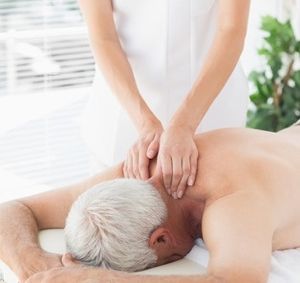- Home
- Western Massage
- Geriatric Massage
As an affiliate for Bookshop, Amazon, and other programs, I may earn a small commission for products purchased through links. This doesn't affect the price you pay. Privacy policy and disclosures.
Search this site:
What Is Geriatric Massage and Its Benefits?
Some massage therapists offer or specialize in geriatric massage. They work with older adults who have needs and conditions that require modification of standard massage techniques.
There is no typical older adult. Some seniors are still healthy, vigorous, and active and may want traditional Swedish or deep tissue massage, while others have conditions that require special attention and techniques.
Benefits of Geriatric Massage
Massage for seniors can have the same benefits as other massage, including relaxation, stress relief, reduced pain, increased flexibility, improved sleep, better mental outlook, and immune support.
In addition, geriatric massage can address specific problems: arthritis pain, stroke recovery, balance and gait issues, and Alzheimer’s disease or other dementia. For example, studies suggest massage helps reduce the agitated behavior associated with dementia.1
What Is Geriatric Massage Training?
Although there's more than one approach to massage for older adults, massage therapists need to be aware of age-related changes:
- Older people are more likely to be dealing with painful conditions such as arthritis and spinal problems.
- Mature skin is more susceptible to bruising and tearing because it's less thick and elastic and contains less moisture than younger skin.
- Less mobile older adults may have poor circulation, diminished lung capacity, and poor muscle strength and tone.
- Older adults are more likely to have conditions that make massage inadvisable, including contraindications such as abdominal aneurysm, blood clot, vein inflammation, or severe swelling.
Specialized training prepares massage therapists to deal with the physical and mental changes that occur as a person ages. Basic massage training for geriatrics usually includes the following topics:
- Physiological, psychological and sociological aspects of aging
- How to determine clients' needs
- Cautions for and contraindications of massage for seniors
- How to adapt standard massage techniques and use special techniques suitable for the physical condition of each individual client
Training typically includes considerations for working with clients in hospitals, retirement centers, nursing homes, and hospice and for interacting with medical professionals, caregivers, and family members.
Advanced workshops may focus on specific ways to massage people who have had a stroke or heart attack; who have diabetes, Alzheimer's or other dementia, Parkinson’s disease, or arthritis; who are confined to bed or use a wheelchair; or who are dying.
Providing massage to older adults can also psychologically affect massage therapists, especially those who work with dying people. Learning to deal with these issues is part of a good training program.
Geriatric massage therapist Joan S. Lohman wrote2 that massage therapists who provide massage for seniors need to develop attitudes and professional skills that support both the therapist and the client. It's important to know how to set boundaries, wait patiently, and honor individual differences.
Types of Geriatric Massage
One resource for specialized training is the DAYBREAK Geriatric Massage Institute. Massage therapist Dietrich W. Miesler founded the institute and developed techniques specifically for conditions often experienced by older adults. Miesler wrote about his theories and techniques in a four-part series in Massage & Bodywork from Fall 1998 to April/May 1999.
For example, Miesler developed "fluffing," which is a combination of effleurage and petrissage designed to increase circulation without damaging frail blood vessels caused by blood thinners. Another of his techniques is "butterfly tapotement," which is a gentle, loose drumming with the fingertips.
Miesler also believed deep tissue massage is not appropriate for elderly clients who have less muscle mass and a lower pain threshold and that massage sessions should be no longer than 30 minutes. Plus, he developed a specific protocol for massaging clients with type 2 diabetes.
Another specialized geriatric technique is Comfort Touch®. This nurturing style of acupressure considers the physical and emotional needs of elderly and/or ill clients.
Suggested Books
The Aging Revolution: The History of Geriatric Health Care and What Really Matters to Older Adults
The SPIRIT Method of Massage for Seniors: Raising the Bar
Sources for What Is Geriatric Massage
1Malone, David. "Updates in Research: Massage Therapy for Dementia." Massage Therapy Journal 63, no. 4 (2024). Gale Academic OneFile (accessed February 24, 2025). https://link-gale-com.ezproxy.spl.org/apps/doc/A817998817/AONE?u=spl_main&sid=bookmark-AONE&xid=a7730bef.
2Lohman, Joan S. "Massage For Elders: An Ever-Growing Opportunity." Massage Therapy Journal 40 (2001), pp. 60-79.
Buy essential oils from Aromatics International (recommended).
Rocky Mountain Essential Oils.
Photo Credit: wavebreakmediamicro/123RF Stock Photo




